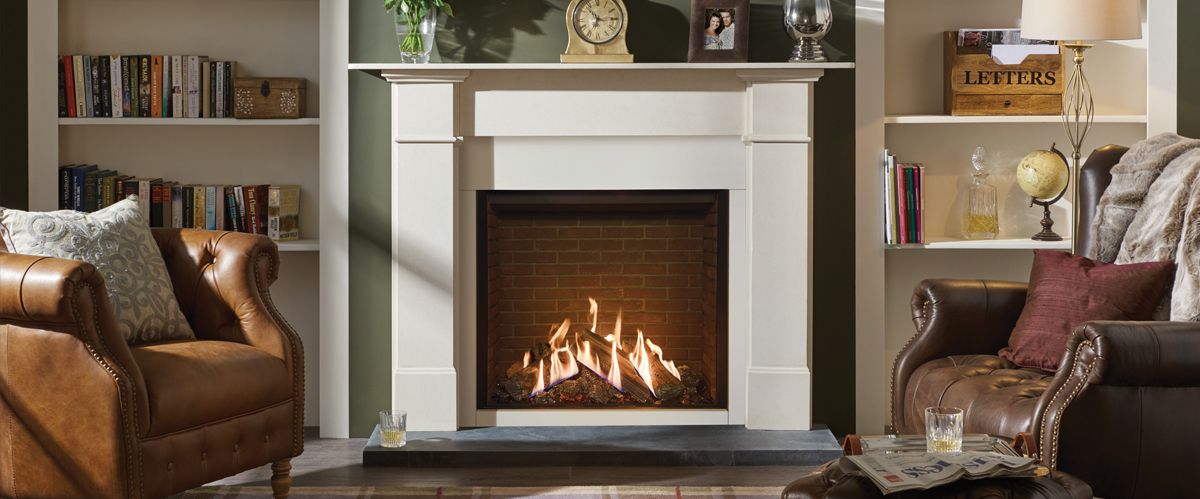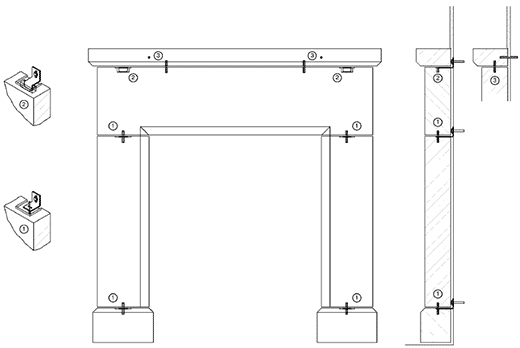
Important Information from the Stone Federation of Great Britain on fitting Stone Fireplaces
DATA SHEET
March 2013
Background to production of this Best Practice Guide for the installation of stone fireplace surrounds.
The objective of this Best Practice Guide is to ensure that stone fireplace surrounds are properly installed and secured in a manner which is both safe for the installer and the homeowner.
There is currently no British Standard for the fixing of stone fireplace surrounds. The fixing of stonework is covered by BS 8298 “Code of Practice for Design and Installation of Natural Stone Cladding and Lining”, and BS 5628 “Code of Practice for use of Masonry – Part 3: Materials and Components, Design and Workmanship”. While these may provide some useful guidance they are not specific to the installation of stone fireplace surrounds.
There have been a number of incidents where stone fireplace surrounds have partially collapsed, resulting in fatalities and serious injuries. Many fireplace surrounds are installed by fitters with little or no formal or appropriate training. Where instructions and guidance are given by manufacturers, it is frequently inadequate or incorrect. A variety of products are currently being used to bed, secure and point fireplace surrounds, many of which are either not suitable or are being used incorrectly.
Scope of this guide
The first edition of this guide covered only solid stone fireplace surrounds where individual stone units are at least 50mm thick and typically 100-150mm thick. In this revision the scope has been extended to include fireplace surrounds formed from thin slabs where the construction is typically of a box type. Artificial stone fireplace surrounds of one piece construction are not included as the fixing ties required to secure them to the wall are normally cast into the surround.
Types of stone covered by the guide
All types of natural and artificial stones including limestone, sandstone, marble, granite and slate.

Safety
Stone fireplace surround installation must only be carried out by a properly trained and experienced fitter. It is a not a job for a DIY enthusiast. The consequences of failure of a stone fireplace surround incorrectly installed and secured are extremely serious. Deaths and serious injuries have occurred as a result of stones falling from fireplace surrounds that were not securely fixed. It is essential that fireplace surrounds are designed to be installed and secured to withstand foreseeable abuse such as a child pulling down on a cantilevered mantel shelf.
Prior to installation a site survey should be carried out to determine the structure of the floor and wall where the surround is to be fitted so that the fitter can be properly prepared and equipped with the correct tools, mechanical fixings and materials. An assessment should also be made of the manual handling required to manoeuvre the stonework into the property and install it in a safe manner.
Mortars, pointing mixes, adhesives and grouts
These should be chosen to suit the type and colour of the stone, and the size and weight of the individual units. Ideally the pointing should match the colour of the stone. For fireplace surrounds formed of solid stonework, where a good mortar bed is particularly important, mortars should consist of an aggregate and cement. The objective is to produce a mortar of the same hardness as the stone.
The choice of aggregate will depend on the type, colour and texture of the stone and may include sand or stone dust. For example, for soft limestones the best aggregate is stone dust produced from the same type of stone as that being fitted and, preferably, with the addition of lime to the mix. Sandstones are best bedded on a sand and cement mix using a suitably coloured sand to match the stone. The coarseness of the aggregate will depend on the texture of the stone being used. For harder limestones and stones that take a polish, such as marbles and granites, it may be more suitable to use an appropriately coloured proprietary adhesive.
Where proprietary bedding materials, cements, adhesives, grouts or additives are used their use must conform to the manufacturer’s guidelines. Such products should only be used for applications approved by the manufacturer. If there is any doubt, the manufacturer should be consulted.
The use of adhesives to bond stone fireplace surrounds to walls is not recommended as they are not sufficient on their own to provide a guaranteed secure bond throughout the lifetime of the fireplace surround. Where walls have been painted there may be inadequate adhesion between the paint and the surface below. Where bonding to plaster there will always be a risk of the fireplace surround becoming unstable should a failure of the plaster occur. The use of mechanical fixings eliminates these risks.
Fixings
Fireplace surrounds are tall, thin structures with little inherent stability and must be restrained by mechanical fixings to the wall. Manufacturers and suppliers of stone fireplace surrounds should ensure that they provide instructions with appropriate diagrams showing the provisions made for mechanical fixings. These should include the type, quantity and position of fixings required for each individual fireplace surround and not be a generic set of instructions.
Fixings should generally be stainless steel although, in some cases, galvanised iron may be acceptable. Ferrous ungalvanised fixings are not recommended. Residual moisture in the stone from the cutting process and water included in bedding materials may cause ferrous fixings to rust and give rise to failure of the fixings or staining of the stone. Stainless steel screws and plugs may be used to fix brackets to walls formed from brickwork or dense concrete blocks but must be of sufficient size to suit the fixings used and resist being pulled out of the wall.
Brackets fixed to lightweight blockwork must be secured using resin anchors as the strength of the blocks is insufficient for ordinary screws and plugs to be tightened. Pull-out data should be available from the block manufacturer. Brackets must not be fixed to the stonework using screws and plugs as there is a risk of the stone fracturing when the screws are tightened.
Natural stone, although strong under compression, is weak under tension. If in any doubt advice should be sought from the manufacturers of the fireplace surround, the bricks/blocks or the fixings.
Fitting procedure
As with any structure a good foundation is fundamental. The type and nature of foundation required will depend on the design of the fireplace surround but must be sufficient to support the entire weight of the stonework. In general, mechanical fixings between the stonework and the wall are solely for restraint purposes and should not be load bearing. In the case of cantilevered stones such as mantel shelves, the fixings should also be able to resist tipping or uplift forces.
Stone fireplace surrounds are best fixed directly to walls formed of brickwork or dense concrete blockwork. Where dry lining is present fixings must pass through the lining to be secured to a solid wall behind. Where a fireplace surround is to be fitted against a studwork wall the wall must be strengthened sufficiently and fixings must be located so as to pass through the plaster board and be secured in the studs. Wall plugs that are secured only to the plaster board are not sufficient. Stone fireplace surrounds should not be fitted to lightweight metal stud walls.
In properties with traditionally plastered brick walls the plaster can be cut back to enable the fireplace surround to be fixed directly to the brickwork behind. The plaster can then be made good around the fireplace surround. If the plaster is of sufficient thickness it will help keep the surround in place but mechanical fixings must still be used.
Each stone forming the fireplace surround must have a fixing or fixings holding the stone in position against the wall. Collectively the fixings must prevent movement either laterally or away from the wall. Fixings in joints between two stones can be linked to each stone using a dowel enabling one bracket to restrain two stones. Where this is not possible the fixing must have a downturn into a mortice in the stone. Where possible, manufacturers should incorporate all necessary mortices and dowel holes into the fireplace surround before delivery to site.
Fireplace surrounds formed from thin slabs in a box type construction will often have hidden stone blocks glued on for the attachment of fixings. The adhesive used for joining these blocks to the main surround must be strong enough to provide a bond equal to that of the fixing with the wall and must be of a type that will not deteriorate over time and weaken the structure.
Fixings must be recessed into the beds of stones for the following reasons:
a) Fixings that are not recessed may increase the thickness of the joints giving an unsightly appearance.
b) The upper stone may be resting on the fixing and not the mortar if the mortar is insufficiently thick.
Porous stones such as limestones and sandstones must be wetted before applying a full bed of mortar in order to stop suction removing the water from the mortar and reducing its ability to adhere to the stone.
Stones must not be spot bedded but a complete bed of mortar must be applied to each stone. This is especially important if the surround has a separate mantel shelf where to only spot bed could prove dangerous. Mechanical fixings must still be used even if a full bed of mortar is applied.
The mantel shelf, as with all other components of the fireplace surround, must be adequately restrained. Special care must be taken with mantels which have a heavily moulded overhang as they are especially susceptible to tipping if leant on or hung on by a child. Mechanical fixings must be used that prevent the stone from tipping. Pointing of the joints can be done using the same mortar as used for bedding or with a suitable grout. Care should be taken to avoid smearing the face of the stone.
End User
It is important that the home owner is provided with instructions on the safe use of their stone fireplace surround, in particular the types of domestic work activities that can/cannot be carried out on the stone fireplace surround. This information should also include the types and weights of objects i.e. photo frame, vase, etc. that the mantel shelf is designed to accept. Where an existing fireplace surround is in place and there are no signs of instability there is no easy way to tell if it has been installed properly. If the homeowner is concerned they should consult an experienced fitter or stonemason for advice. It should be possible to install additional fixings but each case would have to be assessed individually as there is no solution that is universally applicable.
Stone Federation Great Britain believes that this advice contained in this document is in accordance with the latest technical developments and good practice. No responsibility is accepted by the Federation, its servants or agents, in respect of the application of this advice to a specific project.
© Stone Federation GB